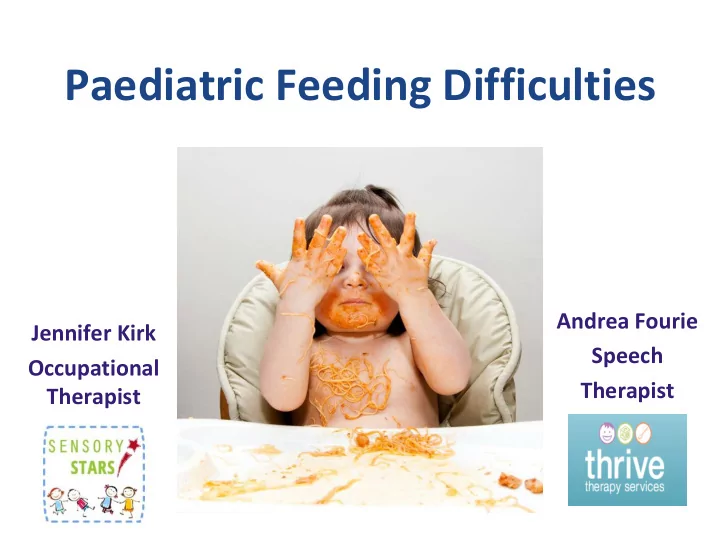

Paediatric Feeding Difficulties Andrea Fourie Jennifer Kirk Speech Occupational Therapist Therapist
Objectives Talk Two: • Allergies and introduction of solids • Causes of paediatric feeding disorders • General treatment strategies • Ethical considerations Andrea Fourie & Jennifer Kirk 2019
Objectives Talk Two: • Allergies and introduction of solids • Causes of paediatric feeding disorders • General treatment strategies • Ethical considerations Andrea Fourie & Jennifer Kirk 2019
Allergies and Introducing Solids • What are common allergens? Andrea Fourie & Jennifer Kirk 2019
Allergies and Introducing Solids • All children should be exposed to allergens before 12 months at age • Documented family history/early allergen reactions (i.e. CMPA) – Referral to a paediatric dietician/allergologist – Between 4-6 months exposure (tastes/play) – Volume (spoon feeding) only once developmentally ready – Ongoing exposure regularly (Chan, et al. 2018) Andrea Fourie & Jennifer Kirk 2019
Causes of Feeding Disorders Medical Nutritional Factors Feeding Skill Psychosocial Conditions Factors Factors Disorders that affect oral, Undernutrition/ Oral sensory Developmental nasal or pharyngeal Overweight functioning delay/disorder function Aerodigestive disease Micronutrient deficiency Oral motor Mental/Behavioural Airway Macronutrient deficiency functioning Health Pulmonology Need for tube feeding Gastrointestinal Heart Disease Dehydration/ Pharyngeal sensory Social Constipation processing and/or motor functioning Neurological, Environmental developmental and psychiatric disorders (Goday, et al. 2019) Andrea Fourie & Jennifer Kirk 2019
Sensory Strategies • Ensure the child is calm and regulated before starting any feeding – Read child’s level of arousal before meal time (over or under aroused = dysregulated) • Reduce the sensory demands of the environment – Light, noise, TV/distractions, smells • Build in sensory prep activities before feeding Andrea Fourie & Jennifer Kirk 2019
Sensory Strategies Calming Activities Exciting Activities Quiet and predictable sounds loud and unpredictable sound - Quiet and slow voice - loud and fast voice - Calming music - loud music Slow linear vestibular movement Fast, blast movement Deep pressure light touch - Deep pressure hugs - squashing - massage Heavy muscle work - climbing - pushing and pulling - carrying Andrea Fourie & Jennifer Kirk 2019
Stages of Sensory Development Acceptance Touch Smell Taste Eating (Ernsperger & Stegen-Hanson, 2004) Andrea Fourie & Jennifer Kirk 2019
Food Chaining • List of foods that have the same features – Texture, flavour or aftertaste • “A child will eat what he likes” • Change one small thing at a time Breaded Breaded Breaded fish Breaded pork chicken vegetable Nugget with Nugget with Nugget with Nugget with tomato sauce BBQ sauce tartar sauce chili sauce (Fraker et al, 2007) Andrea Fourie & Jennifer Kirk 2019
Motor Strategies • Postural support and stability – Alignment, pelvis, foot and shoulder stability – Consideration of feeding chairs • Select foods based on the child’s developmental level and oral-motor skill • Demonstrate how to chew, manipulate and move the food around your mouth (Ernsperger & Stegen-Hanson, 2004) Andrea Fourie Eating Workshop 2017
Environmental Strategies • Boundaries – Respect the child’s autonomy and don’t force anything into his mouth – Role-models are important – Everyone eats the same meal – Child size portions – The child chooses if and how much they eat, the adult choses where and what. (Ernsperger & Stegen-Hanson, 2004) Andrea Fourie Eating Workshop 2017
Environmental Strategies • Mealtime behaviours – Don’t force the child to eat – Be supportive and provide appropriate models for eating regardless of behaviour – Routine prior to eating • Wash hands and wipe face with warm washcloth • Wipe table and have a damp face cloth during the meal • Set table – No distractions/tv/screen time Andrea Fourie Eating Workshop 2017 (Ernsperger & Stegen-Hanson, 2004)
Ethical Considerations • Scope of practice – Professional practice – Skill set, training and experience • Referral Pathways – Multidisciplinary Assessments/Treatment • Cultural consideration • Family stress during mealtimes/social events • Parental beliefs • Food availability Andrea Fourie & Jennifer Kirk 2019
Case Study • Grade R Child • Dx: SPD and motor planning • Diet: white foods, nandos, McDonalds chips (perfect), white bread, pink lady apples, barbie banana yoghurt, vanilla ice-cream, iced tea, formula in a bottle • Oral motor - low oral tone, no lateralisation, anterior, messy eater, no utensil use. • Neophobia - visual and smell. Visual gagging • Caregiver use of inappropriate strategies - bombarding with everything (food), bargaining and manipulation Andrea Fourie & Jennifer Kirk 2019
Questions……? Andrea Fourie & Jennifer Kirk 2019
References • American Speech-language and Hearing Association. (n.d.). https://www.asha.org/public/speech/swallowing/Feeding-and-Swallowing-Disorders- in-Children/ Accessed on 01 October 2019. • Centers for Disease Control and Prevention. (n.d.). https://www.cdc.gov/nutrition/infantandtoddlernutrition/foods-and-drinks/when-to- introduce-solid-foods.html Accessed on 01 October 2019. • Chan, et al. (2018). Early introduction of foods to prevent food allergy. Allergy, Asthma and Clinical Immunology, 14, 93-101. • Ernsperger & Stegen-Hanson. (2004). Just Take a Bite . Future Horizons. • Fraker et al. (2007). Food Chaining: The proven 6-step plan to stop picky eating, solve feeding problems, and expand your child’s diet . Da Capo Press. • Goday, et al. (2019). Pediatric Feeding Disorder — Consensus Definition and Conceptual Framework. Journal of Pediatric Gastroenterology and Nutrition, 68 , 124-129. • Hurley, et al. (2008). Maternal symptoms of stress, depression, and anxiety are related to non-responsive feeding styles in a statewide sample of WIC participants. Journal of nutrition, 138, 799-805. • Miller et al. (2007). Concept evolution in sensory integration: a proposed nosology for diagnosis. The American Journal of Occupational Therapy, 61, 135-140. • Törölä, et al. (2012). Feeding skill milestones of preterm infants born with extremely low birth weight (ELBW). Infant behavior & development, 35, 187-194. Andrea Fourie & Jennifer Kirk 2019
Recommend
More recommend